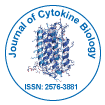Unsere Gruppe organisiert über 3000 globale Konferenzreihen Jährliche Veranstaltungen in den USA, Europa und anderen Ländern. Asien mit Unterstützung von 1000 weiteren wissenschaftlichen Gesellschaften und veröffentlicht über 700 Open Access Zeitschriften, die über 50.000 bedeutende Persönlichkeiten und renommierte Wissenschaftler als Redaktionsmitglieder enthalten.
Open-Access-Zeitschriften gewinnen mehr Leser und Zitierungen
700 Zeitschriften und 15.000.000 Leser Jede Zeitschrift erhält mehr als 25.000 Leser
Indiziert in
- Google Scholar
- RefSeek
- Hamdard-Universität
- EBSCO AZ
- ICMJE
Nützliche Links
Open-Access-Zeitschriften
Teile diese Seite
Abstrakt
A Note to Cytokines
Alireza Heidari*
Cytokines are important regulators of cell and tissue development, migration, differentiation, and differentiation. Inflammatory cytokines like interleukins and interferons, growth factors like epidermal and hepatocyte growth factors, and chemokines like macrophage inflammatory proteins, MIP-1 and MIP-1 are all members of this family. The endocrine system's peptide and steroid hormones are not included. Cytokines play critical roles in chemically induced tissue repair, cancer growth and progression, cell replication and apoptosis regulation, and immune response modulation such as sensitization. They have the potential to be sensitive indicators of chemically induced functional perturbations, but toxicologically, the detection of cytokine changes in the whole animal is constrained by the fact that they are locally released, with plasma measurements being usually inaccurate or insignificant, and they have short half lives that require precise timing to detect. Flavonoids' The term cytokine derives from the Greek terms kytos, which means "hollow" or "vessel," and kinein, which means "to pass." It was first used to differentiate a group of immuno-regulatory proteins that are known as interleukins from other chemicals known as growth factors that modulate the proliferation and the bioactivation of nonimmune cells. However, as more information about these proteins has become available, it has become clear that the distinction between these two concepts is artificial, and that many of the traditional immuno-modulatory cytokines will affect proliferation and differentiation in both immune and nonimmune cells. Chemokines are a third class of soluble chemo-attractant cytokines, and interleukin-8 was one of the first to be identified (IL-8). Chemokines are made up of a large number of proteins, each with its own receptor, and involve molecules like RANTES. Most cytokines have stimulatory or inhibitory effects, and they can work together or against other cytokines and hormones. A key feature of their behaviour is that a individual cytokine can cause one form of reaction in one set of circumstances while causing the exact opposite reaction in another set of circumstances.
Zeitschriften nach Themen
- Allgemeine Wissenschaft
- Biochemie
- Chemie
- Genetik und Molekularbiologie
- Geologie und Geowissenschaften
- Immunologie und Mikrobiologie
- Klinische Wissenschaften
- Krankenpflege und Gesundheitsfürsorge
- Landwirtschaft und Aquakultur
- Lebensmittel & Ernährung
- Maschinenbau
- Materialwissenschaften
- Medizinische Wissenschaften
- Pharmazeutische Wissenschaften
- Physik
- Sozial- und Politikwissenschaften
- Umweltwissenschaften
- Veterinärwissenschaften
Klinische und medizinische Fachzeitschriften
- Anästhesiologie
- Augenheilkunde
- Betrieb
- Dermatologie
- Diabetes und Endokrinologie
- Gastroenterologie
- Genetik
- Gesundheitspflege
- Immunologie
- Infektionskrankheiten
- Kardiologie
- Klinische Forschung
- Medizin
- Mikrobiologie
- Molekularbiologie
- Neurologie
- Onkologie
- Pädiatrie
- Pathologie
- Pflege
- Toxikologie
- Zahnheilkunde

 English
English  Spanish
Spanish  Chinese
Chinese  Russian
Russian  French
French  Japanese
Japanese  Portuguese
Portuguese  Hindi
Hindi